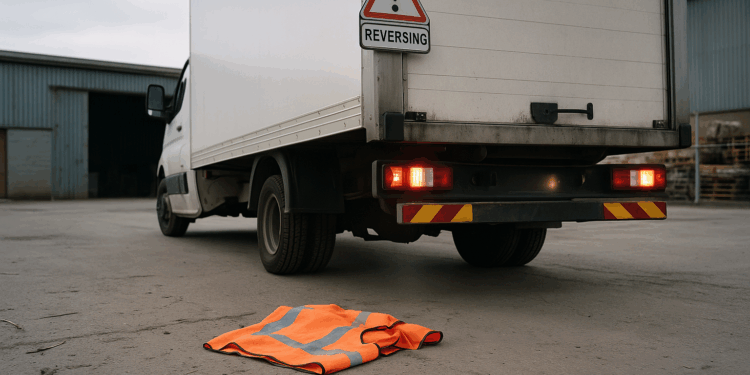Story Highlight
– Reversing vehicles cause 16% of work-related fatalities.
– Average of 21 lives lost annually due to vehicle strikes.
– Fines reached £2.5 million for preventable failures.
– Key solutions include safe site designs and training.
– Effective risk management can eliminate workplace transport deaths.
Full Story
Every year in Great Britain, countless families endure the heart-wrenching loss of a loved one due to accidents involving reversing vehicles at work. These incidents are not merely statistics; they involve individuals whose lives are tragically cut short by accidents that could have been avoided.
Data shows that incidents involving moving vehicles account for 16% of all fatal work-related injuries. Over the last five years, this has resulted in an average of 21 deaths each year, positioning it as one of the primary causes of work-related fatalities in the UK. A significant number of these incidents involve workers being struck by vehicles that are reversing.
The increasing frequency of such tragedies has highlighted the pressing need for attention to this issue. Recently, fines for workplace safety breaches have soared to £2.5 million, illustrating a disturbing trend in avoidable failures related to vehicle safety.
John Rowe, Deputy Director for Technical Support and Engagement at the Health and Safety Executive (HSE), emphasises the simplicity of the failures behind these fatalities. “What strikes me most about these cases is not the complexity of the failures, but their simplicity,” he stated. “Time and again, we see deaths that could have been prevented by basic measures that cost far less than the fines that are ultimately imposed.”
The data reveals a worrying pattern across various industries: agriculture accounts for 27% of vehicle-related fatalities, while both construction and transportation/storage each represent 17%. Despite the clear recognition of these trends, practical solutions remain straightforward, provided employers are willing to enact them effectively.
The underlying causes of these incidents are often predictable. Workers are frequently struck when vehicles reverse in areas where pedestrians and vehicles share space, often exacerbated by inadequate visibility for drivers due to malfunctioning reversing aids. Furthermore, a lack of designated safe routes for pedestrians and poorly managed traffic flow contributes significantly to these tragedies.
Safety is often an afterthought, with delivery schedules taking precedence over necessary precautions such as having dedicated banksmen on site. Reversing cameras, critical for safety, often remain unrepaired due to perceived high costs, while pedestrian walkways may be overlooked entirely on sites that have “managed without them” in the past.
To combat workplace transport fatalities, it is crucial to embed safety into the operational fabric of work sites right from the outset. Addressing risks and committing to adequate control measures must take priority before any vehicle is in motion.
Effective site design plays a vital role in enhancing safety. This includes establishing dedicated walkways with physical barriers to separate pedestrians from vehicles, implementing one-way traffic systems to minimize the need for reversing, and situating loading areas away from worker activity zones. Furthermore, ensuring adequate lighting throughout the site can vastly improve visibility for drivers.
Vehicles themselves must be thoroughly maintained and equipped with essential safety devices. Reversing aids should not be viewed as optional extras but as vital safety features. Systems such as CCTV, audible alarms, and sensors are critical for helping drivers identify potential hazards that may not be immediately visible. Regular inspections of vehicles should be commonplace, and any vehicle deemed defective should be promptly removed from service until repairs are completed.
The role of personnel in maintaining safety cannot be overstated. Drivers must be trained to recognise the specific risks they encounter, understand when to call for a banksman, and feel empowered to halt operations when safety conditions deteriorate. This training should extend beyond basic vehicle operation to encompass the specific safety considerations of the environment in which they work.
Moreover, it is not sufficient to merely establish safety measures; it is equally imperative to ensure all employees adhere to these standards. Managers and supervisors are encouraged to actively engage with staff, challenging and investigating any unsafe practices they observe to promote a culture of safety.
As the headlines highlight the substantial fines of £1 million and £2.5 million, it is essential to remember that these figures represent more than just financial repercussions—they reflect communities shattered by entirely preventable accidents. Sectors such as agriculture, forestry, and fishing experience the loss of six workers annually due to vehicle strikes, while construction and transportation/storage each suffer four fatalities, underscoring that deaths could be eliminated through rigorous management practices.
Organisations must commit to embedding proactive measures to prevent workplace transport fatalities consistently. This requires thorough risk assessments, stringent maintenance of equipment, and empowering workers to identify potential hazards before they result in accidents.
Extensive guidance on improving workplace transport safety is available through relevant health and safety organisations, aimed at ensuring that such tragic events become a rare occurrence rather than a distressing norm.









This is a stark reminder that basic site safety and vehicle management are lifesaving priorities. Design sites so vehicles and pedestrians do not mix, use clear one way flows and segregation, fit vehicles with audible and visual warning systems and ensure banks of mirrors or banks of trained spotters where visibility is poor. Conduct thorough task specific risk assessments, keep vehicle maintenance up to date and provide practical reversing training rather than tick box theory. Managers must be accountable and workers empowered to stop unsafe operations. These steps are not costly compared with the human and financial cost of a single fatality.